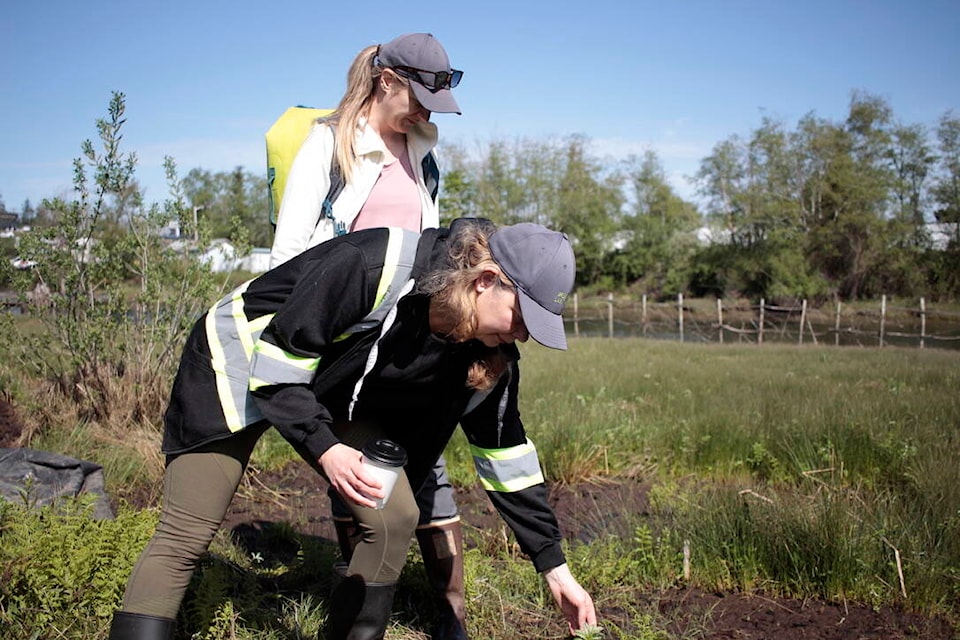Camille Andrews and Katie Lavoie made sure to bring their gumboots to Baikie Island on a recent trip to check on the progress of a project to remove the invasive yellow flag iris from the Campbell River estuary.
The boots were a good idea, because as soon as they left the trail they stepped into mud and sunk a few centimetres above their ankles. The muddy trail led into the estuary itself, which at low tide looked like a grassy field. Though the winter rains have largely stopped, the low-lying area has held onto a lot of moisture and regularly gets replenished by the tides. Unfortunately, this area has turned out to be an ideal habitat for yellow flag iris, which can take over an area, stifling growth of native species and turning a once vibrant salt marsh into a monoculture of yellow flowers.
The solution? Benthic barriers. These heavy plastic tarps are laid on top of the yellow flag iris and buried about 30 centimetres deep on four sides to prevent both sunlight and oxygen from reaching the plants, a process Lavoie described as being like “putting a fitted bed sheet on a bed made of mud.”
After a few years, the patch under the mats are completely bare, leaving space for native plants to return. The only question now is whether or not to give the native plants a helping hand.
“We’re doing a combination of planting native plants that should be here after we lift (the mats) and then some we’re just leaving to regenerate,” Andrews said. “We’re going to compare after a couple years and see if it’s worth re-planting … it’s kind of costly labor-wise.”
Though at low tide, the estuary looked a lot like any other grassy field — albeit a bit wetter than most — the real value is seen when the tide comes in.
“If you imagine all of this when the tide is high, it’s an amazing system for the salmon,” Andrews said. “There would be tons of places to hide a lot of sources of bugs and things – food – so really productive for juvenile salmon.”
What makes places like the Campbell River estuary special is the overlapping ecosystems. Life tends to flourish near the edges of ecosystems. This is true for things like hedgerows, riversides and marshes at the end of estuaries.
“Wherever you have two habitats meeting, it’s great for biodiversity,” Andrews said. “There’s kind of like three habitats in one. You’ve got the riparian edge, you’ve got this fringe area that includes sweet gale and willow, and then you have the true marsh out here. That combination just means that for birds and wildlife there are so many different plants that they can rely on for food and shelter.
“Because the tide comes up, it’s also an amazing aquatic habitat,” she added. “It has food sources and places to hide from predators.”
”I think people dismiss it here too because they’re like ‘ah, it’s grass, it’s muddy,’” Lavoie said. “Just because you don’t think that it’s beautiful doesn’t mean it’s super important.”
What Andrews loves most about the estuary are the little pops of colour that come up every spring.
“What makes my heart happy is being out here looking at that Henderson’s checker-mallow … We’ve got lots of paintbrush and rice root and bog orchids and cool things like that.”
Though tarping the yellow flag iris is left to Greenways staff and contractors — the organization works with We Wai Kai and We Wai Kum Guardians among other groups in the area — there is some work that volunteers can do in the estuary area. As Andrews and Lavoie left Baikie Island, they passed by piles of invasive brush cut by volunteers, as well as a few native plant planting sites. Any interested volunteers can register at www.greenwaystrust.ca/volunteer.
RELATED: New funding coming to Campbell River, Puntledge watersheds for Fish and Wildlife projects
Junior Streamkeepers make a difference at Campbell River pond
marc.kitteringham@campbellrivermirror.com
Like us on Facebook and follow us on Twitter
